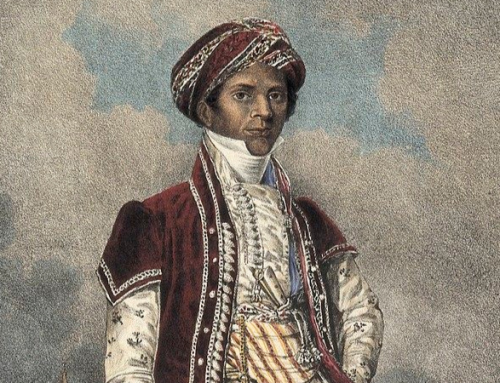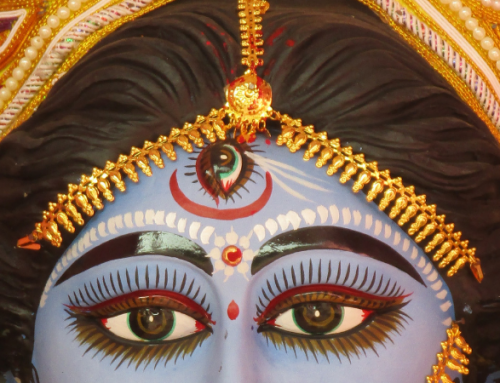Never Before Seen Writing of the Aghori Vimalananda & Letters of His Family’s Guru
Though regularly I rail against misuse of the internet, that enormous network continues to surprise me to my benefit. Just a few weeks ago someone kindly sent me this URL for a website dedicated to Pagal Haranathand his consort Kusum Kumari.
Also known as Haranath Thakur, Pagal Haranath (pagal meaning mad or crazy) lived between 1865 and 1927. Though Haranath established no cult his influence has been tremendous. During his life he wrote a number of letters to devotees, many of which can be found on this site. Here is an example:
Blessed is Prakriti! Blessed are Her strength and power of infatuation! She is the Supreme Ruler of the Universe and destiny of people is in Her hands. Some She destroys today and some She preserves for destruction tomorrow. With the single exception of Krishna, everyone is engaging in Her service. Dreading Her, I have taken shelter in Krishna.
What interests me most about Haranath is that he was the guru of Vimalananda’s parents, and I was excited to find on this site corroboration for stories that Vimalananda had told me about him. For example, there is a detailed account of the April 1896 event that transformed Haranath’s life as he was about to journey from Jammu to Srinagar. At three in the afternoon he lost consciousness and was given up for dead. His heart had stopped beating, all signs of life had disappeared, and his travelling companions made arrangements for the body to be cremated. At one o’clock the following morning however he revived, and claimed to have experienced communion with a Mahapurusha (Great Being) whom he had seen before as a child of five while out walking with his elder brother. During this period of ‘death’ the Mahapurusha dismembered Haranath’s body into 64 parts. On reassembling them, three were found to be missing. The Mahapurusha therefore made up the missing parts with ‘earthly-matter taken from the hills’, and Haranath revived.
In Aghora Vimalananda retells this story and adds:
Can you guess which three pieces were thrown away? The Three Gunas: sattva, rajas, and tamas. He put the other sixty-one pieces together again and suddenly the man came back to life, and was given instructions by my Mahapurusha. Eventually he became my parents’ guru, and in that way my Mahapurusha could look after me while I was growing up. Haranath always used to tell my parents, “My boy,” meaning me, “will move about in fine suits of clothes and no one will ever know him.”
Vimalananda further explains how Haranath left his reconstituted body permanently in May 1927:
In 1927 my father came down with meningitis and died. Yes, he died; I can show you death certificates signed by three different doctors. We received a message from Haranath immediately: “Don’t remove the body for twelve hours after death.” All our relatives said, “Don’t be stupid. He’s dead now, let’s cremate him.” But my mother had implicit faith in her guru and she was adamant. After six hours the corpse sat up. He lived for another fifty-one years.
A few days later my father received a letter from Haranath: “My son, you will have a long life, but you will never see your Haranath anymore. Look after my boy,” meaning me; I was eleven at the time. A cover letter from Haranath’s son was enclosed which stated that on such-and-such a day at such-and-such a time his father had gone to sleep in his garden after mentioning that he felt my father needed his help. Haranath never woke from that sleep. The time he went to sleep turned out to be exactly the moment my father revived.
After this experience my father was a changed man. Although he had not had much interest in his business before, after this incident he lost all interest in business and would spend his time doing japa or discussing spiritual subjects with my mother.
When in 1978 Vimalananda’s father finally died for good I accompanied Vimalananda to pay our last respects to the old man before we took the body to the Banganga smashan. As we entered his room Vimalananda whispered to me, “Look at that face!” Then he pointed to a portrait on the wall whose features looked to my eye to be almost identical to those of the old man, and said, “That fellow on the wall is Haranath Thakur, our family guru. My father concentrated on his picture for so many years that he became like his guru even in physical form. This is a practical demonstration of the Kita Bhramari Nyaya, the Law of Caterpillar and Butterfly: Whatever you concentrate on you will eventually become.”
As synchronicity would have it, I am currently in the middle of typing into a file a group of notes and literary sketches that Vimalananda wrote with his own hand and collectively termed “My Musings”. He always intended to publish these, and perhaps one day they will appear in print. Today just before I saw to write this post I decided to type in one more page – and the page that came up next to be entered was entitled “Extracts Taken from Haranath Leelamruta”, Haranath Leelamruta being a collection of Haranath’s teachings. Vimalananda consigned this selection to paper on October 25, 1948, not long before he turned 32, and it seems most appropriate to me that I end this post with it (jiva is the individual soul):
If we examine our environments we shall see that this is the nature of the soil through which we have all to pass, we are all born to it. Lust or desire for self-enjoyments and its outcome sensuousness are part and parcel of a jiva’s present material life, and as for material wealth, gold or its equivalent in value, as long as we have to carry our physical frame with us we can never do without it. Our physical body has to be sustained with food and one of the names given to eatables is wealth.
Shastras say that Lakshmi Devi, the goddess of wealth and consort of Narayana, enriches man. She is in charge of all the foodstuffs in the creations, and part of her work is to distribute them to the various jivas in the creations in the proportion they become entitled to by virtue of their deserts or religious merits acquired in their present life and also of past birth.
We always forget that all our sense organs are defective and the perceptions received through them are necessarily so, having no reliability in them. We never for a moment think that it is our intelligence, the chit-shakti (chit being grossly translated as consciousness) in us that perceives, and that the said consciousness in us is always steady.
Maya to deceive us and to keep us reconciled to our lot created so many things to keep our consciousness always engaged, and these things exert their influence on us by giving rise to either pleasure or pain in us. Under the pressure of those perceptions we can never know what this our consciousness at rest is or by itself would be like. Everything in the creation is moving – is in a state of constant whirl and vibration – and our consciousness too, in forgetfulness of its own nature, seems to be doing so.


